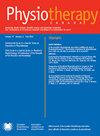老年体能测试的虚拟与亲身体验比较:随机交叉试验
IF 0.8
4区 医学
Q4 REHABILITATION
引用次数: 0
摘要
老年人体能测试 (SFT) 是一种经过验证的工具,用于检查老年人的活动能力、力量和柔韧性。在 COVID-19 大流行期间,由于现场培训设施关闭,因此需要有效的虚拟评估方案,包括 SFT。本研究的目的是对经过验证的 SFT 进行比较。将经过修改的虚拟版 SFT 与经过修改的面对面验证版 SFT 进行比较。通过随机数字生成器将居住在社区的老年人随机分配到面对面或虚拟修改版 SFT 体验模式中。在完成第一种授课模式(即面对面授课或虚拟授课)后,参与者完成第二种授课模式。40 名参与者(50% 为女性;72 ± 4 岁)的 2 分钟台阶测量结果显示,亲自递送和虚拟递送之间没有差异(亲自递送的平均值[M] ± 标准差 = 87.9 ± 18.5;虚拟递送的平均值 = 87.2 ± 20.7;P = 0.65)、30 秒卷臂(本人 = 16.9 ± 4;虚拟人 = 16.5±4;P = 0.43)、30 秒椅上站立(本人 = 15.6 ± 5;虚拟人 = 15.2 ± 4;P = 0.36)和椅上坐伸(本人 = 1.2 ± 15;虚拟人 = 4.2 ± 11;P = 0.06)。如果无法进行面对面测试,在虚拟环境中进行修改后的 SFT 可能是一种对老年人和医疗保健专业人员有用的测试模式。本文章由计算机程序翻译,如有差异,请以英文原文为准。
A Virtual Versus In-Person Comparison of the Senior Fitness Test: A Randomized Crossover Trial
The Senior Fitness Test (SFT) is a validated tool for examining older adults’ mobility, strength, and flexibility. During the COVID-19 pandemic, when in-person training facilities were closed, there was a need for effective virtual options for assessments, including the SFT. The purpose of this study was to compare the validated SFT conducted in person versus an online virtual setting. A virtual modified version of the SFT was compared to the modified in-person validated SFT. Community-dwelling older adults were randomized, using a random number generator, to start in either the in-person or virtual modified SFT mode of delivery. After completion of the first mode of delivery (i.e., either in-person or virtual), participants completed the second mode of delivery. Forty participants (50% women; 72 ± 4 years) showed no differences between the in-person and virtual delivery measurements in the 2-minute step (mean [ M] ± standard deviation in person = 87.9 ± 18.5; M virtual = 87.2 ± 20.7; p = 0.65), 30-second arm curl ( M in person = 16.9 ± 4; M virtual = 16.5±4; p = 0.43), 30-second chair stand ( M in person = 15.6 ± 5; M virtual = 15.2 ± 4; p = 0.36), and chair sit and reach ( M in person = 1.2 ± 15; M virtual = 4.2 ± 11; p = 0.06). Performing the modified SFT in a virtual setting may be a useful delivery mode for seniors and healthcare professionals if in-person testing is not viable.
求助全文
通过发布文献求助,成功后即可免费获取论文全文。
去求助
来源期刊

Physiotherapy Canada
REHABILITATION-
CiteScore
1.90
自引率
20.00%
发文量
93
审稿时长
>12 weeks
期刊介绍:
Physiotherapy Canada is the official, scholarly, refereed journal of the Canadian Physiotherapy Association (CPA), giving direction to excellence in clinical science and reasoning, knowledge translation, therapeutic skills and patient-centred care.
Founded in 1923, Physiotherapy Canada meets the diverse needs of national and international readers and serves as a key repository of inquiries, evidence and advances in the practice of physiotherapy.
Physiotherapy Canada publishes the results of qualitative and quantitative research including systematic reviews, meta analyses, meta syntheses, public/health policy research, clinical practice guidelines, and case reports. Key messages, clinical commentaries, brief reports and book reviews support knowledge translation to clinical practice.
In addition to delivering authoritative, original scientific articles and reports of significant clinical studies, Physiotherapy Canada’s editorials and abstracts are presented in both English and French, expanding the journal’s reach nationally and internationally. Key messages form an integral part of each research article, providing a succinct summary for readers of all levels. This approach also allows readers to quickly get a feel for ‘what is already known’ and ‘what this study adds to’ the subject.
Clinician’s commentaries for key articles assist in bridging research and practice by discussing the article’s impact at the clinical level. The journal also features special themed series which bring readers up to date research supporting evidence-informed practice.
The Canadian Physiotherapy Association (CPA) is the national professional association representing almost 15,000 members distributed throughout all provinces and territories. CPA’s mission is to provide leadership and direction to the physiotherapy profession, foster excellence in practice, education and research, and promote high standards of health in Canada.
 求助内容:
求助内容: 应助结果提醒方式:
应助结果提醒方式:


